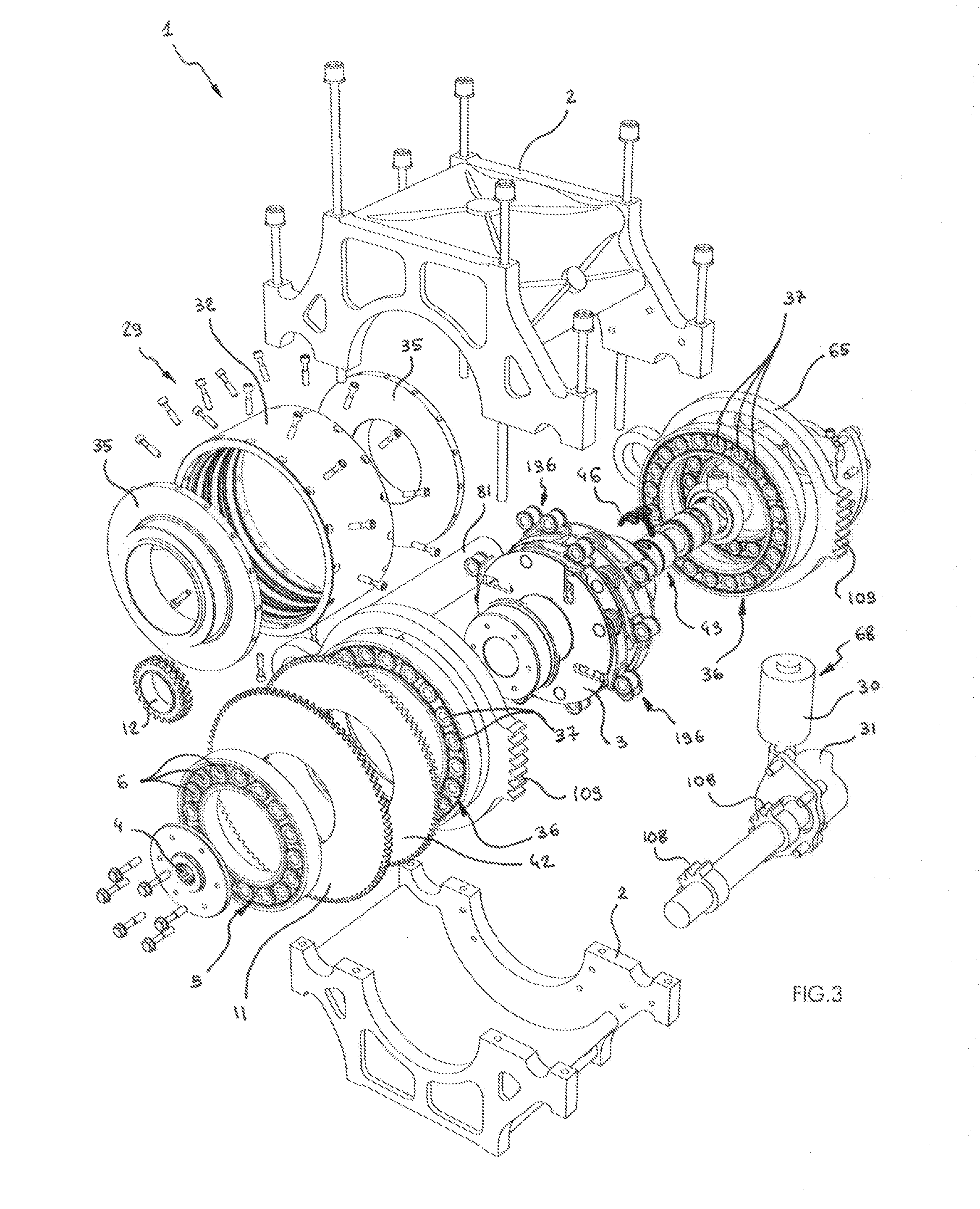These four strategies are found alone or in combination in various types of transmissions that can be combined with various heat-electric, heat-pneumatic or heat-hydraulic
hybrid devices, each configuration involving a compromise between various advantages and drawbacks, without any being fully satisfactory in practice.
Furthermore, said transmissions are coupled with the
heat engine using a dry disc
clutch that only dissipates the energy during gear shifting, and in a small quantity.
The main drawback of this configuration is relative slowness in shifting gears, which results—for the vehicle's driver—in an unpleasant
sensation of loss of continuity in the transmission of the power.
The problem with the latter solutions is their cost, which limits them to transmissions for high-end and high-performance vehicles.
However, dual-
clutch transmissions remain heavier, more expensive and bulkier than traditional manual transmissions.
However, their output remains mediocre, since they involve considerable energy losses, whether due to the
torque converter, any “lock-up”
clutch, ratio selection clutches, and the various pump(s) and actuators that they include.
Unless they are extremely, or even excessively expensive to produce, continuously variable transmissions generally have a lower mechanical output than that of manual transmissions with
involute gear pairs.
However, hydraulic continuously variable transmissions accommodate high speeds of revolution poorly and have the drawback of having a low average output, said output varying greatly based on the speed and torque to be transmitted.
Furthermore, the durability of the storage offered by said means makes the latter more or less effective in reducing the
energy consumption of motor vehicles based on the frequency and type of journeys they perform.
Used as
secondary energy storage means,
electricity nevertheless poses various problems, including the limited charge power of the electrochemical storage devices.
The latter in fact only make it possible to store a limited fraction of the vehicle's
kinetic energy during braking thereof, particularly regarding braking with a high deceleration.
Another problem is that the lifetime of the storage devices is reduced to a limited number of charge-
discharge cycles, whereas a very large number of braking operations are done over the lifetime of the motor vehicle.
These two problems may be resolved through the use of electrostatic storage devices—also called “super capacitors”—but the latter are too expensive for wide scale use in the automotive field.
Although they are more affordable, electrochemical storage devices nevertheless also remain expensive and require rare materials, while their manufacturing and recycling potentially
pose various environmental problems.
Furthermore, the higher the output of the electrical components of the propulsion
system of a heat-electric
hybrid motor vehicle is, the higher the cost to manufacture said components will be.
KER Shave the
advantage of a
high energy storage and
recovery power, but on the other hand are expensive and potentially dangerous, generate unwanted gyroscopic effects, and only store the energy for a limited amount of time.
Secondary energy storage using a pressure accumulator is difficult to apply to motor vehicles due to the high speeds of rotation of the heat engines used in those vehicles, said speeds being difficult to reconcile with the axial
piston or radial piston hydraulic motor-pumps according to the state of the art, which are only capable of the necessary pressure and
energy performance levels.
Furthermore, the operating pressure of said motor-pumps remains relatively low, below 500 bar, which requires heavy and bulky pressure accumulators to store the
secondary energy necessary for energy optimization of the vehicle, such accumulators being difficult to house in a private passenger vehicle.
In practice, when they are used to transmit mechanical work, hydraulic motor-pumps have a low output compared to that of
involute gear pairs.
The storage pressures remaining relatively low, the accumulators remain bulky and take up a large portion of the body understructure of the vehicle while only storing a very small quantity of energy.
The use of hydraulic pumps suffers from various pitfalls and contradictions.
However, said
high pressure reduces the
volumetric efficiency of said pumps because not only are the leak flow rates of the latter increased for a same level of sealing, but said flow rates are higher relative to the flow rate of said pumps.
Likewise, at isopressure, the more the displacement of a
hydraulic pump is reduced to meet the instantaneous usage needs of a transmission, the greater its friction losses and sealing losses become relative to the work capacity transmitted by said pump.
Furthermore, it will be noted that the need for high outputs remains, due in particular to the issues of
controllability of the displacement of the various pumps and / or hydraulic motor-pumps used; issues of continuity of the
power transmission, which must not be affected by the pulsations from the transmitting hydraulic pumps and the receiving hydraulic motor-pump(s); and the acoustic and
cavitation erosion issues, the high operational pressures causing strong mechanical biases and potentially violent expansions of
hydraulic fluid.
This is even more sensitive given that—for cost and bulk reasons—said pump can only include a limited number of cylinders, in particular in the context of a transmission for motor vehicle use.
Whichever
hypothesis is selected, the
hydraulic pump by “Artemis Intelligent Power©” remains relatively expensive to manufacture, and the reliability and
electricity consumption of its input / output solenoid valves biased upon each revolution remain crucial points.
Although effective under certain usage conditions, the “Floating Cup” pump has many leak passages, and its
volumetric efficiency is greatly decreased as a result, particularly with partial displacements.
 Login to View More
Login to View More  Login to View More
Login to View More 


